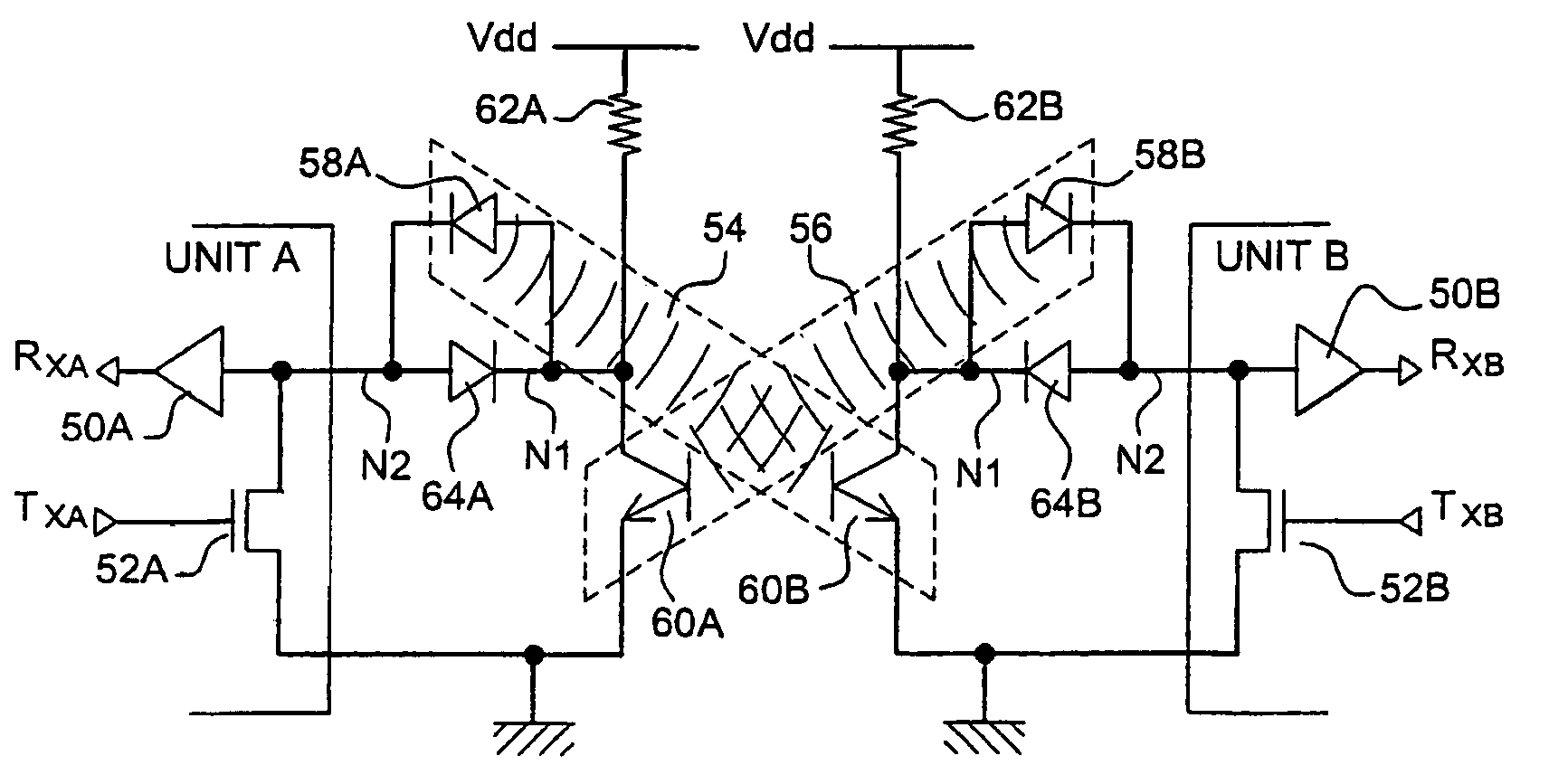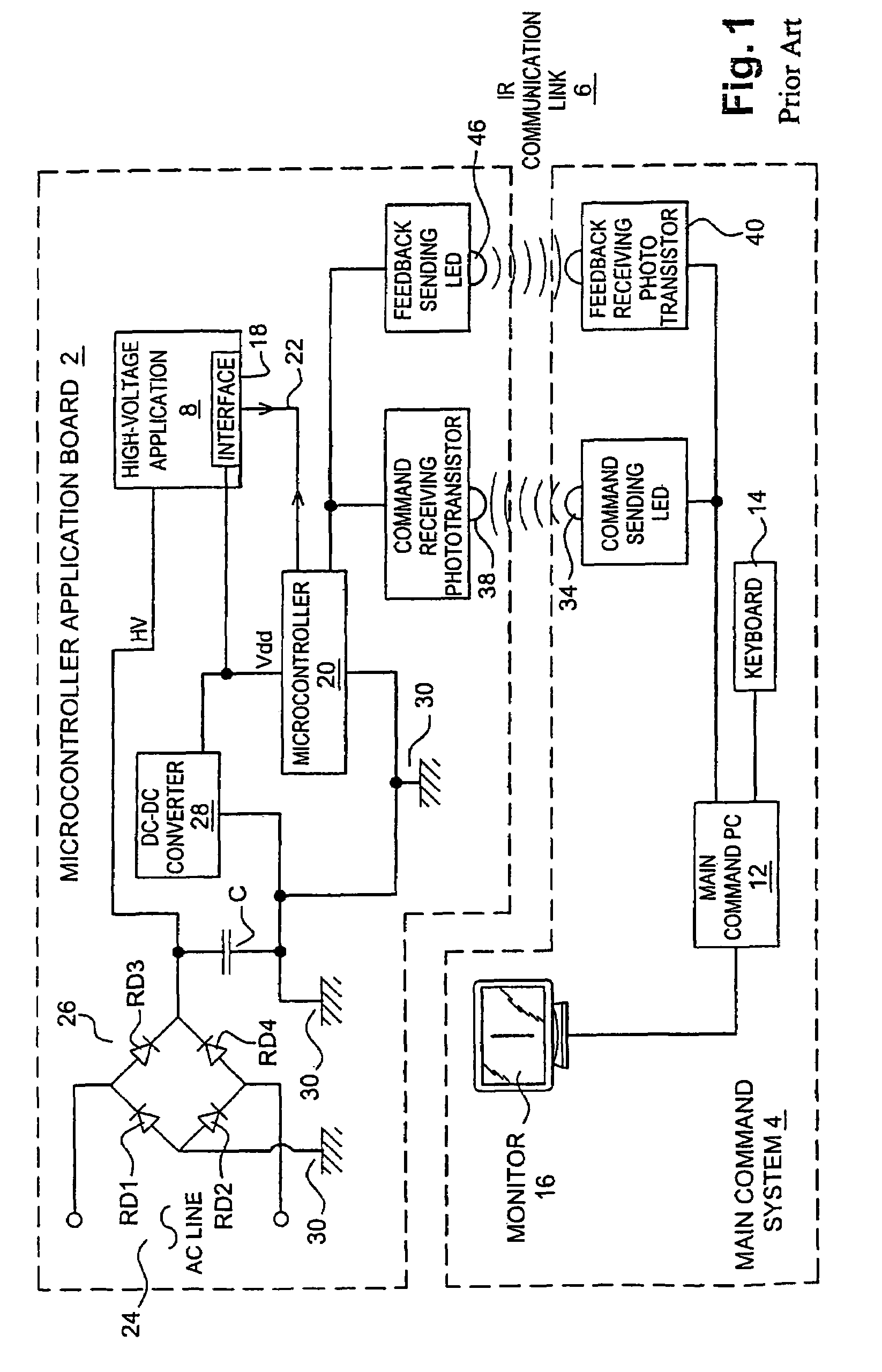Optical coupling device and method for bidirectional data communication over a common signal line
a technology of optical coupling and signal line, which is applied in the direction of optical light guides, counting objects on conveyors, photoelectric discharge tubes, etc., can solve the problems of potential danger either for the user or the circuitry, the inability of opto-isolators to be interposed in the data wire path, and the inability to use opto-isolators
- Summary
- Abstract
- Description
- Claims
- Application Information
AI Technical Summary
Benefits of technology
Problems solved by technology
Method used
Image
Examples
first embodiment
[0093]The circuit diagram of the invention is shown in FIG. 5. The embodiment is based on the same two units A and B as in FIG. 3 communicating by the same protocol and the same internal circuitry as already described in connection with that Fig., notably as regards the buffer 50A / 50B and transmission FET switch 52A / 52B. Accordingly, the two units A and B exchange data using the common bidirectional serial data link DCL as described. Also, a system of two logic type opto-isolators 54 and 56 is present in that common data link DCL to isolate the units A and B.
[0094]In FIG. 5, elements having already been described in the context of FIG. 3 have the same reference numerals as in FIG. 3 and, for the sake of conciseness, shall not be described again insofar as they have the same form or function, it being understood that the above description of features of FIG. 3 common to FIG. 5 are hereby incorporated by reference.
[0095]The circuit of FIG. 5 differs from that of FIG. 3 notably in that...
second embodiment
[0129]The circuit of FIG. 7 shows this variant implemented with the In this case, additional pull-up resistors 662A / 662B and the resistors 66A / 66B form a voltage divider between Vdd and ground when the phototransistor of their respective unit is conducting (ignoring VCEsat of that phototransistor).
[0130]Now, with such a circuit configuration, the additional pull-up resistors 662A / 662B can be placed physically either:[0131]outside the unit A or B with which they are associated, whereupon they can be biased by a power supply serving for the opto-isolators 54 and 56, which is independent of the power supply for the unit A or B itself. This configuration is shown inFIG. 8A for the case of unit A, or[0132]within the unit A or B with which they are associated, for instance if the additional pull-up resistors 662A / 662B are already present on chip. This configuration is shown in FIG. 8B for unit A. In this case, the same power supply of the unit A or B serves to bias both the pull-up resis...
third embodiment
[0134]FIG. 9 shows the invention, based on the embodiment of FIG. 3, with a connection at each end to a totem-pole coupler circuit. Most phototransistors have open collector outputs, but in very-high speed opto-coupling applications, totem-pole output photodetectors can be used instead. This variant calls for a modification of the previous circuit diagram, since the pull-up resistor is replaced by an active component, as illustrated.
[0135]Specifically, FIG. 9 shows the circuit configuration simply for unit A, it being understood that the configuration is the same for unit B.
[0136]At the level of the head-to-tail Schottky diode 64A and LED 58A, there is added a series resistor 70 having a first terminal connected to the anode of LED 58A and its second terminal connected to the cathode of Schottky diode 64A. Series resistor 70 serves to limit the current through LED 58A. In the previous embodiment, the current through that LED is limited by the pull-up resistor, absent from this circu...
PUM
 Login to View More
Login to View More Abstract
Description
Claims
Application Information
 Login to View More
Login to View More - R&D
- Intellectual Property
- Life Sciences
- Materials
- Tech Scout
- Unparalleled Data Quality
- Higher Quality Content
- 60% Fewer Hallucinations
Browse by: Latest US Patents, China's latest patents, Technical Efficacy Thesaurus, Application Domain, Technology Topic, Popular Technical Reports.
© 2025 PatSnap. All rights reserved.Legal|Privacy policy|Modern Slavery Act Transparency Statement|Sitemap|About US| Contact US: help@patsnap.com



